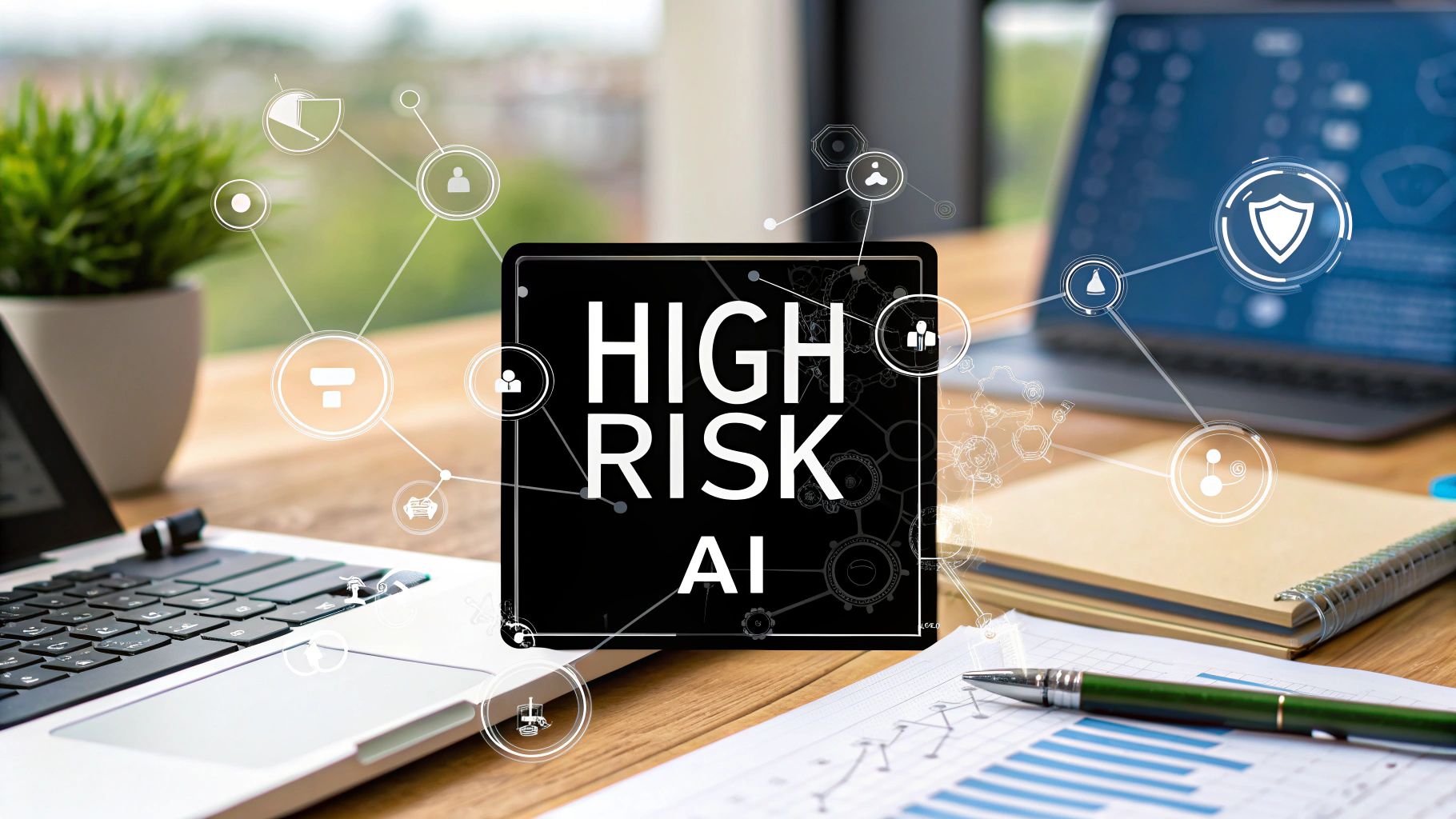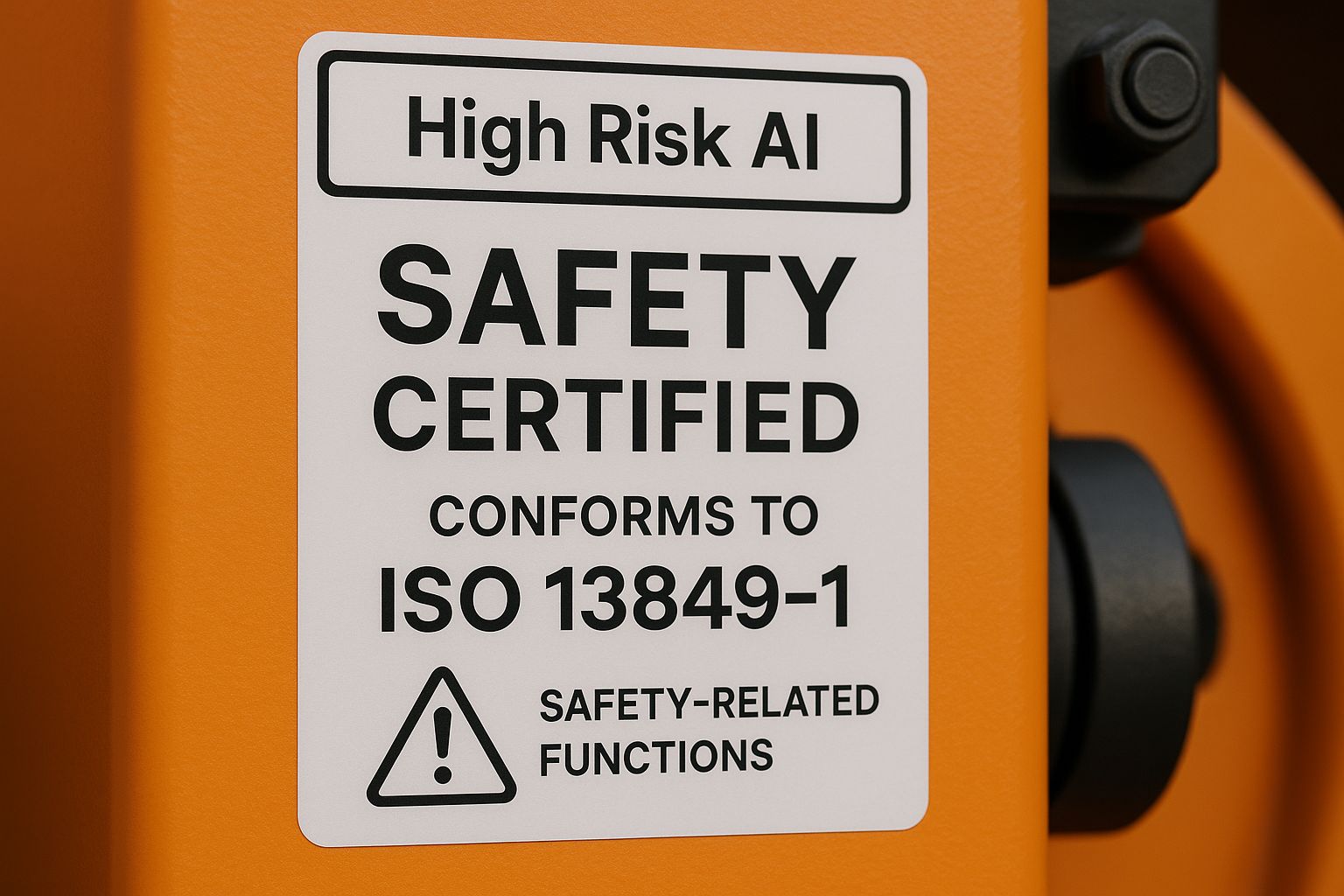
A Practical Guide to High Risk AI
Under the EU AI Act, high risk AI isn't just a technical buzzword. It's a specific legal classification for systems that could pose significant harm to people's health, safety, or fundamental rights. If you do business in the European Union, this formal designation comes with a hefty set of compliance obligations you can't ignore.
Unpacking the Concept of High Risk AI
When regulators talk about high risk AI, they're not picturing some self-aware robot from a sci-fi movie. They're talking about the practical AI systems already in use today that make decisions with real weight behind them.
Think of it like safety certifications for physical products. A child's toy and a commercial airliner are both regulated, but the level of scrutiny for the plane is worlds apart because the potential for harm is so much greater.
The EU AI Act applies that same logic to software. An AI that curates your workout playlist falls into a completely different bucket than one that helps doctors diagnose diseases or screens candidates for a job. These latter systems are deemed high risk because a glitch or a biased outcome could have severe consequences, from a missed medical diagnosis to outright employment discrimination.
A Risk-Based Regulatory Framework
The EU's entire approach is built on a tiered system: the stricter the rules, the higher the potential for harm. This framework aims to strike a balance between encouraging innovation and demanding safety, making sure the most powerful technologies get the most rigorous oversight. This structure is what helps businesses figure out exactly what's required of them.
This infographic lays out the hierarchy the EU AI Act uses to classify AI systems based on their potential impact.

As the image shows, "High Risk AI" is a specific, regulated category, much like a formal safety rating on a critical piece of machinery. To make sense of this, the Act sorts all AI into four distinct risk levels, each with its own rulebook.
The core idea is simple: the greater the potential risk an AI system poses to a person's health, safety, or fundamental rights, the tougher the legal requirements it must meet before it can ever be deployed.
This risk-based method keeps the regulation proportional. To get a clearer picture, the table below breaks down these categories and what each level means for developers and businesses. Understanding this structure is the first and most crucial step in navigating your compliance journey.
EU AI Act Risk Categories at a Glance
| Risk Level | Description | Regulatory Action |
|---|---|---|
| Unacceptable Risk | AI systems considered a clear threat to the safety, livelihoods, and rights of people. Examples include social scoring by governments or real-time remote biometric identification in public spaces by law enforcement (with narrow exceptions). | Banned. These systems are prohibited from being placed on the EU market. |
| High Risk | AI systems that negatively impact safety or fundamental rights. This includes AI used in critical infrastructure, medical devices, employment, and law enforcement. These are legal but face strict obligations. | Strict Compliance Required. Subject to rigorous requirements, including risk management, data governance, human oversight, and conformity assessments before being placed on the market. |
| Limited Risk | AI systems with specific transparency obligations. This category includes chatbots or AI-generated content (deepfakes), where users must be informed they are interacting with an AI. | Transparency Obligations. Users must be aware they are interacting with an AI system so they can make an informed decision to continue. |
| Minimal Risk | AI systems that pose little to no risk to citizens' rights or safety. This includes the vast majority of AI systems in use today, such as AI-enabled spam filters or video games. | No specific legal obligations. Providers of these systems may voluntarily adopt codes of conduct. |
Grasping where your AI system fits within these four tiers is essential. It dictates not just your legal obligations but also the entire lifecycle of your product, from initial design and data handling to post-market monitoring.
How the EU Defines a High-Risk AI System
Figuring out if an AI system is considered high-risk isn't just guesswork; it's a specific legal test laid out in the EU AI Act. The regulation doesn't care so much about the underlying technology as it does about the AI's intended purpose and how it's used in the real world.
There are two main pathways for an AI system to earn this classification.
The first path is through Annex II of the Act. It applies to AI systems that are intended to be used as safety components of products already covered by existing EU safety harmonisation legislation. Think about the AI managing a self-driving car’s brakes, guiding a surgical robot, or a safety feature in a child's connected toy. If that AI component fails and could put someone's health or safety on the line, it’s automatically deemed high-risk.
The second path, outlined in Annex III, is much broader and deals with standalone AI systems operating in sensitive areas that could impact fundamental rights.
The Annex III List: High-Stakes AI in Action
This list is really the heart of the matter for most software companies. It pinpoints specific applications where a faulty or biased AI could seriously harm a person's life opportunities, legal rights, or overall well-being. These aren't theoretical problems—they are real-world uses with major consequences.
Here are a few of the critical areas called out in Annex III:
- Biometric Identification: Systems used for remote biometric identification of natural persons.
- Critical Infrastructure: The AI that manages and operates essential private and public infrastructure like water, gas, and electricity.
- Education: Systems used to determine access to educational institutions or to evaluate students.
- Employment: AI tools that screen resumes, make hiring decisions, or evaluate employee performance.
- Access to Services: Algorithms that evaluate creditworthiness or determine eligibility for public assistance benefits.
- Law Enforcement: AI used for assessing the risk of a person committing an offense or evaluating the reliability of evidence.
If your business operates in any of these domains, getting familiar with Annex III is non-negotiable. If your product fits one of these descriptions, it is presumed to be a high-risk AI system, triggering a demanding set of compliance rules. You can dive deeper into what makes up different AI systems in our other guide.
Here's the key takeaway: The exact same AI technology can be low-risk one day and high-risk the next, all depending on its intended purpose. An algorithm that recommends movies is minimal risk. But if you tweak that same algorithm to filter job applications, it instantly becomes a high-risk system.
This "context is everything" approach means you can't just look at your technology in a bubble. You have to think carefully about how and where your customers are actually using it. That intended purpose is the bedrock of the entire EU AI Act.
Your Compliance Checklist for High Risk AI

So, you've determined your system falls into the high-risk AI category. That's the first hurdle. Now comes the real work: understanding and meeting the legal obligations that come with that classification. The EU AI Act isn’t just a list of principles; it’s a detailed, practical framework with specific requirements you’ll need to prove you're following. This checklist will break down those core obligations into manageable steps.
Think of this less like a one-time exam and more like obtaining a certification that requires continuous maintenance. You must implement robust processes, continuously monitor your systems, and keep meticulous records to demonstrate ongoing compliance. The entire point is to build a culture of accountability around your AI.
This is more important than ever as regulators worldwide start paying closer attention. While a single global approach to governing high-risk AI hasn't quite materialized, legislative activity is skyrocketing. Mentions of AI in laws across 75 countries jumped by 21.3% between 2023 and 2025—a staggering ninefold increase since 2016. Even with all this new legislation, there’s often a gap between knowing the risks and actually putting safety measures in place, which makes the EU’s concrete rules a crucial benchmark. The Stanford HAI 2025 AI Index Report has some great insights on this growing legislative focus on futureoflife.org.
Foundational Compliance Pillars
Any provider of a high-risk AI system must anchor its strategy in several non-negotiable pillars. These aren't just good ideas; they are mandatory parts of your compliance journey under the EU AI Act.
Establish a Risk Management System: This is the heart of your compliance. You need a continuous, iterative process to identify, evaluate, and mitigate risks the AI could pose to health, safety, or fundamental rights. This isn't just a pre-launch check; it must be maintained throughout the entire lifecycle of the system.
Ensure High-Quality Data Governance: The data used for training, validation, and testing your AI must meet high standards. This means ensuring your datasets are relevant, representative, and free of errors and biases to the greatest extent possible. You'll need to document everything—data provenance, scope, and preparation processes.
Maintain Detailed Technical Documentation: You must have comprehensive documentation ready to go before your AI is placed on the market. It needs to demonstrate that the system meets all the Act's requirements. This is a living document that must be kept updated and available for competent authorities upon request.
Implement Meaningful Human Oversight: This is about more than just having a person nearby. The system must be designed to allow effective human intervention. This includes measures to oversee the system’s operation and, crucially, to step in, override, or shut it down when necessary.
Conduct a Conformity Assessment: Before launch, your high-risk AI system must undergo a formal assessment to prove it meets all legal requirements. For some systems, a provider can perform a self-assessment. For others in more critical fields, a conformity assessment by a third-party Notified Body will be required.
These obligations are all interlinked. Shoddy data governance creates a flawed system, which makes risk management impossible and renders human oversight useless. Each pillar supports the others.
By tackling these core areas with a clear plan, you can create a strong framework that not only keeps you compliant but also builds genuine trust with the people who use your technology. For a deeper dive, our guide on building a complete AI compliance program can help you put all the pieces together. In this regulated space, a thorough approach isn't just smart—it's essential.
Seeing High-Risk AI in the Real World
https://www.youtube.com/embed/v07Y4fmSi6Y
Let's ground all this legal talk in reality. The theory behind the EU AI Act makes a lot more sense when you see how it applies to technology we're already using. So, let's step away from the regulatory text and look at some concrete examples of high-risk AI in action. This is where you can see why such careful rules are needed when an algorithm's decision can change someone's life.
Think about an AI tool built to screen resumes for a large corporation. It’s designed to sift through thousands of applications and create a shortlist for human recruiters. This isn't just a simple sorting tool; it directly impacts a person's "access to employment," which is a classic high-risk category under the Act's Annex III.
If that algorithm was trained on historical hiring data, it could easily perpetuate past biases, systematically filtering out perfectly qualified candidates from certain demographics, schools, or backgrounds. It wouldn't be intentional malice, just a machine repeating human biases at a massive scale. That’s exactly the kind of harm to fundamental rights the regulation is designed to prevent.
Real Scenarios and Their Compliance Demands
Let's break down a couple more distinct cases to see how the technology and the legal requirements connect. Each scenario shows a different angle of risk and what compliance looks like on the ground.
- AI for Credit Scoring: A bank uses an algorithm to decide if you're worthy of a loan. This system processes financial data to generate a credit score, falling squarely into the high-risk category of "access to essential private services." A flawed or biased decision could lock someone out of a mortgage, a car loan, or other crucial financial products.
- AI in Medical Devices: A software system uses AI to analyze medical images (like X-rays or MRIs) to assist doctors in detecting diseases. As an AI component of a medical device, its failure could lead to a misdiagnosis with severe health consequences. This makes it high-risk, subject to both the AI Act and existing medical device regulations.
For every one of these high-risk AI systems, the provider has a clear set of responsibilities. The company that built the resume-screening tool, for example, has to do more than just sell it. They need to prove their data is high-quality and that they've actively worked to mitigate bias. They also have to design for meaningful human oversight, giving a recruiter the final say and the ability to easily override the AI's suggestions.
At its heart, the EU AI Act works on a simple principle: if an AI can shut a door on a person—be it to a job, a loan, or a physical location—it must be held to the highest possible standards of fairness, transparency, and accountability.
Connecting Regulation to Public Concern
This push for regulation isn't just coming from Brussels; it’s a direct response to very real public fears. A recent survey found that 76% of people are worried about AI-powered misinformation. With forecasts suggesting that up to 300 million jobs could be affected by automation, the economic anxiety is just as high. In the US, 63% of workers worry their job could be replaced by AI within the next 10 years.
If you want to dig deeper, you can explore more AI-related trends and statistics to get a clearer sense of the landscape.
How to Prepare Your Business for the AI Act

With the EU AI Act’s deadlines approaching, preparation is no longer a future task—it's an immediate necessity. Shifting from theory to practice is the only way to tackle the very real compliance risks that come with providing or deploying high-risk AI. The first step is to cut through the complexity and map out a clear, strategic plan.
This isn’t just about dodging fines; it’s about building an AI practice that’s both responsible and sustainable. If you start now, you can transform a regulatory headache into a competitive edge, showing your customers that your systems are trustworthy, safe, and fair.
Let's walk through the concrete steps your business can take today.
Conduct a Comprehensive AI Inventory
Let's be blunt: you can't manage what you don't know you have. Your first real-world step is to create a detailed inventory of every single AI system your organization develops, deploys, or uses. This means everything—the systems your teams built from scratch, the third-party models you've integrated into your products, and even the "shadow AI" tools your employees might be using without official oversight.
Your audit has to be exhaustive. For each system, you need to document its intended purpose, what data it's trained on, who the provider is, and where it’s deployed. This complete picture is the absolute foundation of your compliance strategy.
The explosion of generative AI in the workplace really drives this point home. Since 2023, nearly half (45%) of all enterprise employees started using tools like ChatGPT for their daily work. The problem? A staggering 67% of this happens on unmanaged personal accounts. This creates a massive blind spot, making AI the number one way corporate data is leaked. You can read the full research on AI and data security from The Hacker News to grasp just how big this risk has become.
Classify and Prioritize Your Systems
Once you have your inventory, it's time to start sorting. Perform an initial risk classification for each AI system using the EU AI Act's criteria. Is it unacceptable, high, limited, or minimal risk? Pay extremely close attention to any system that fits the use cases listed in Annexes II and III, as those are automatically flagged as high-risk AI.
This classification isn’t just an academic exercise—it tells you where to focus. Your immediate attention and resources should go straight to the systems you've identified as high-risk, since they carry the heaviest legal obligations and the steepest penalties.
This isn't a one-and-done assessment. A system's risk level can shift based on its intended purpose. An internal chatbot that summarizes meeting notes? Minimal risk. But if you take that exact same model and integrate it into a customer-facing system that helps decide who gets a loan, it instantly becomes a high-risk system.
Establish a Robust AI Governance Framework
With your priorities straight, you can now build the internal structure to manage them. Think of an AI governance framework as your company’s rulebook for building, deploying, and monitoring AI responsibly. This framework needs to define who is responsible for what, set clear policies for handling data, and establish the ground rules for risk management and human oversight.
A solid framework makes compliance a continuous process, not just a box to tick before launch. It should absolutely include:
- Clear Policies: Written guidelines on the ethical and compliant use of AI.
- Defined Roles: Assigning specific people or teams (like an AI officer) to own AI compliance and risk.
- Training Programs: Getting everyone up to speed on the AI Act's rules and your internal policies.
- Monitoring and Auditing: Regular check-ins to make sure systems are behaving as expected and staying compliant.
Putting this structure in place is fundamental for long-term success. To get a head start, check out our in-depth guide on building a complete framework for governance, compliance, and risk management. This proactive mindset will prepare you for whatever comes next.
Common Questions About High-Risk AI
The EU AI Act is a big piece of legislation, and it's natural to have questions as you start to figure out where your business fits in. Let's tackle some of the most common things people ask about high-risk AI and what it means for them.
Does the EU AI Act Apply if My Company Is Not in the EU?
Yes, it almost certainly does. The Act has "extraterritorial" reach, similar to the GDPR. It’s not about where your company is based, but where your AI system is placed on the market or put into service.
If you place a high-risk AI system on the market in the European Union, or if the output produced by your AI system is used within the EU, you are subject to the Act's provisions. So, if your product or service is available to anyone in an EU country, you need to comply with the rules.
What Is the Difference Between a Provider and a Deployer?
Understanding your role is one of the first and most important steps. The law defines two main actors, and each has distinct responsibilities.
A provider is the person or entity who develops an AI system and places it on the market or puts it into service under their own name or trademark. Providers carry the heaviest compliance burden—they're responsible for the system's design, technical documentation, quality management system, and conducting the conformity assessment.
A deployer (referred to as a "user" in some contexts) is any entity using a high-risk AI system under its authority, except when the use is part of a personal, non-professional activity. Deployers must use the system according to its instructions, ensure human oversight is in place, and monitor its operation.
The easiest way to think about it is creation versus application. One entity builds the tool, the other puts it to work. Both have critical responsibilities for ensuring it operates safely and fairly.
Can an AI System Change from Low-Risk to High-Risk?
Absolutely. This is a crucial detail that trips up a lot of people. An AI model’s risk level isn't a permanent label; it all comes down to its intended purpose.
A general-purpose AI model, like a language model used for internal brainstorming, may not be high-risk on its own.
But if a provider or deployer integrates that exact same model into a system that makes decisions about people's lives—like a tool for diagnosing medical conditions, a platform for calculating credit scores, or software that filters job applications—the resulting system becomes high-risk AI.
That's why you can't just assess the model once and call it a day. Every time you define a new intended purpose for a system, you have to run a fresh risk assessment against the AI Act's criteria. The context is everything.
Navigating the EU AI Act is complex, but you don't have to do it alone. ComplyACT AI guarantees your compliance in just 30 minutes, with tools to auto-classify your systems, generate technical documentation, and stay audit-ready. Trusted by leaders like DeepMind and Siemens, our platform helps you avoid fines and build trust. Get compliant today.